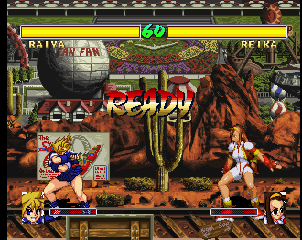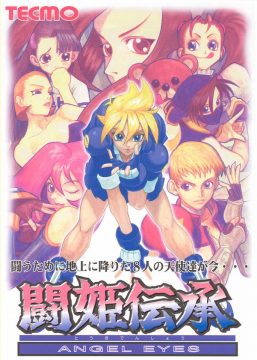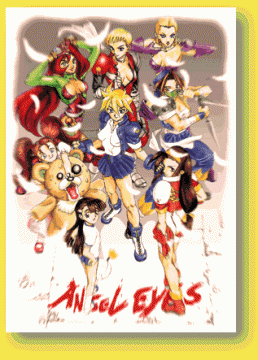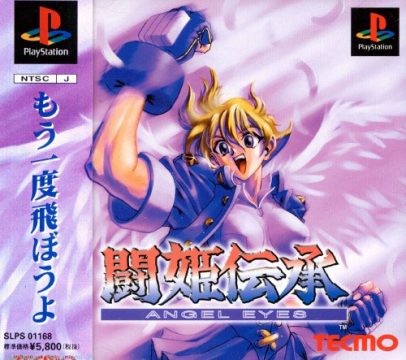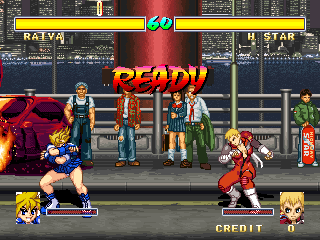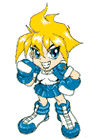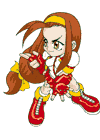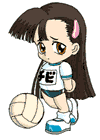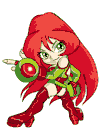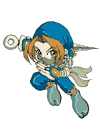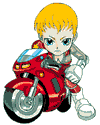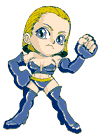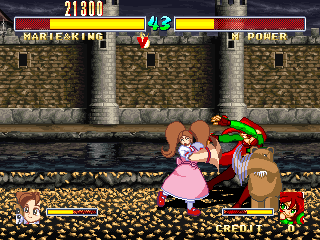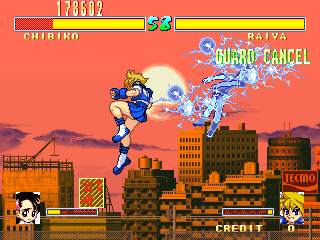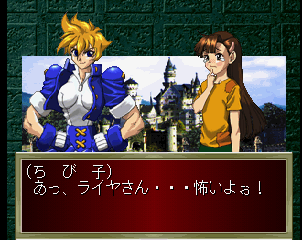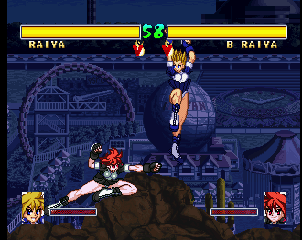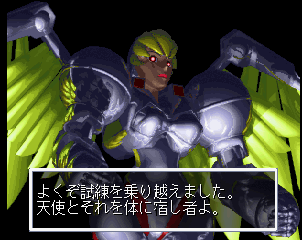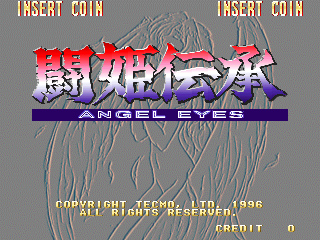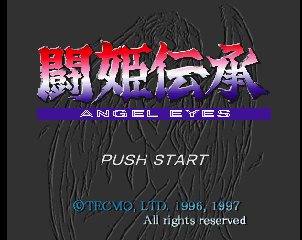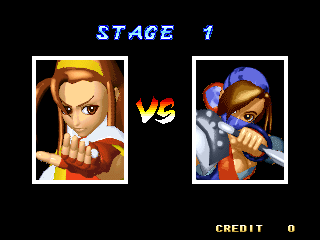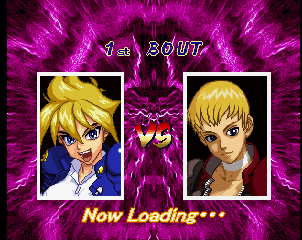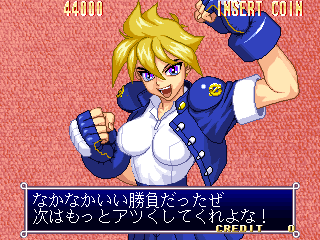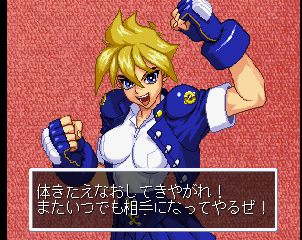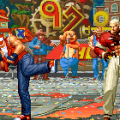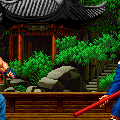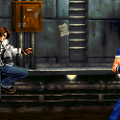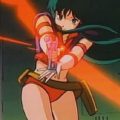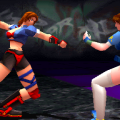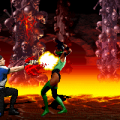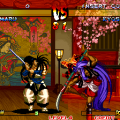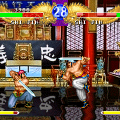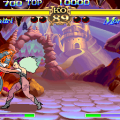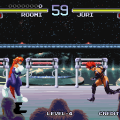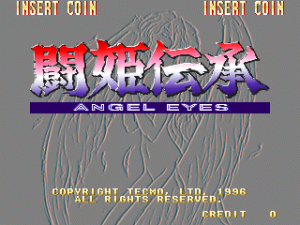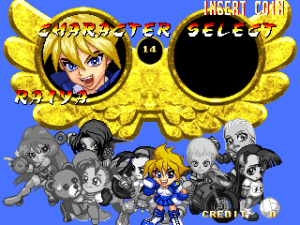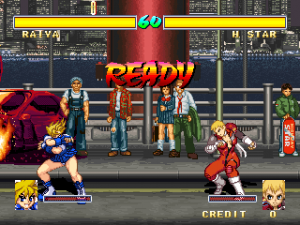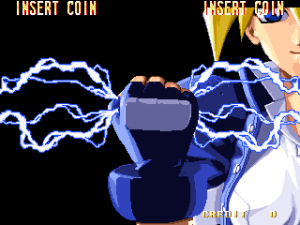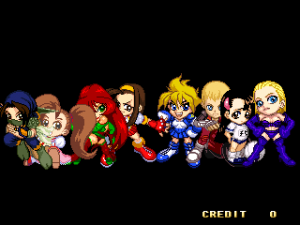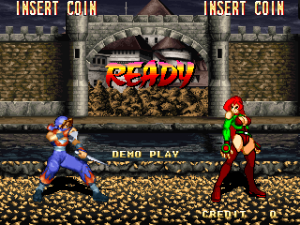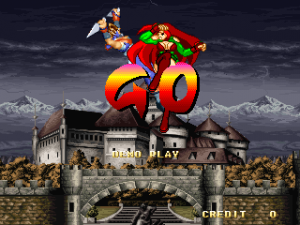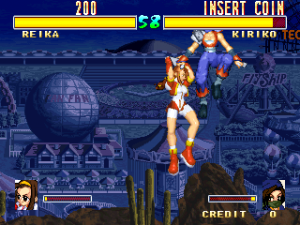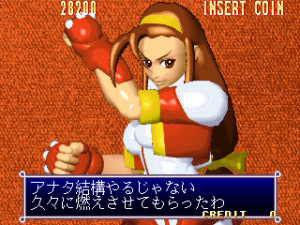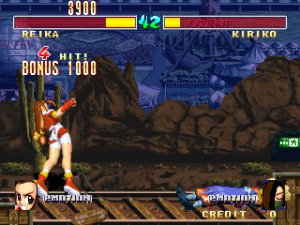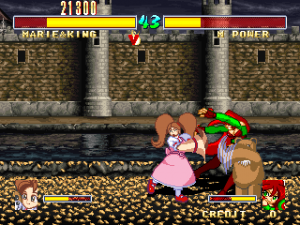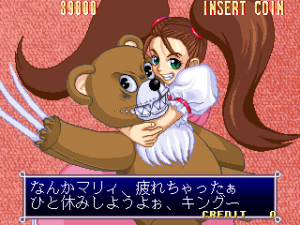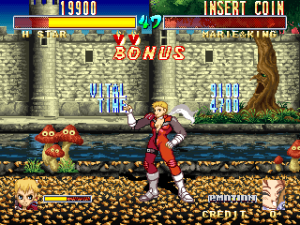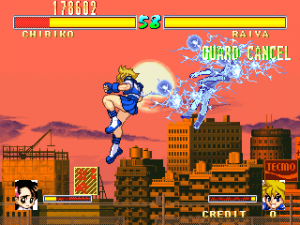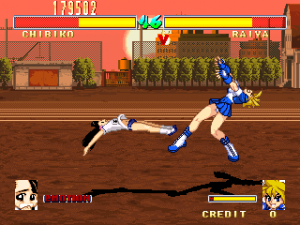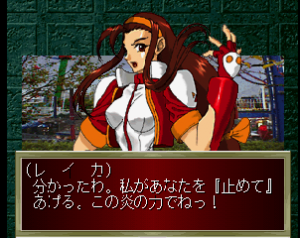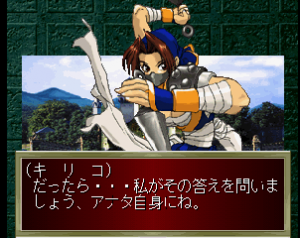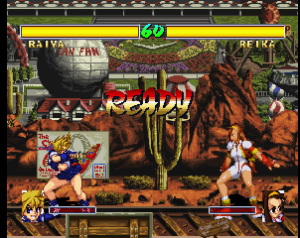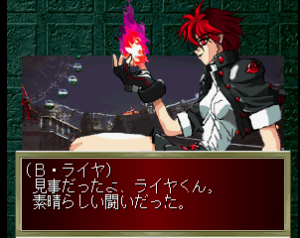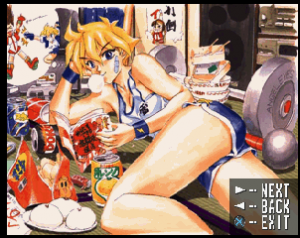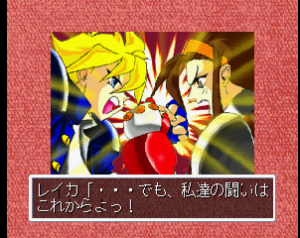Known in the 80s for their cinematic platforming and sports titles, Tecmo (now Koei Tecmo) unfortunately ran into financial issues in the early 90s and needed a strong title to keep themselves afloat; with a weak arcade presence and dwindling console presence limited to Tecmo Bowl and Captain Tsubasa titles, Tecmo looked to developing a few non-sports titles to solve the problem. At the forefront was an attempt at a sequel to the arcade Ninja Gaiden to be released for the Neo Geo in 1994 that was silently canned due to its difficulty and lack of positive feedback— in its stead, three fighting games were to be made using the leftover assets: a ninja-themed game (no, not the Tecmo ninja fighting game you may be imagining), a fairy tale-themed game, and a horseback-themed(!) game.
The ninja game became the only game of the three to be realized, although it was changed to Toukidenshou ~ Angel Eyes ~ (Toukidenshou roughly translating to “Legend of the Fighting Princess”), an all-female fighting game that was released in June 1996 for arcades and later for PlayStation in December 1997, both only in Japan (with a limited arcade release in Asia). However, the game went relatively unnoticed due to a fighting game juggernaut— Tecmo’s own Dead or Alive— being released a few months later for the Sega Model 2 hardware. Both games share credited team members, and the Angel Eyes team was responsible for creating home console ports of Dead or Alive as well as helping work on the arcade update Dead or Alive ++. With virtually all of Tecmo’s available assets being poured into the other fighter, Angel Eyes suffered a harsh development cycle, characterized by team members being reassigned and a lack of resources, especially time. The team even began receiving threats from higher-ups if the game performed poorly! However, despite all the trouble during production it stands as an interesting look into the fighting game genre that was, for all intents and purposes, well ahead of its time in a few areas.
Angel Eyes‘ story revolves around angels sent to Earth to “synchronize” with one of 8 young women strong enough to win in a fighting tournament. Most of the characters attend St. Tehkan Academy (named after Tecmo’s former company name, Tehkan) with a few exceptions. The PlayStation port expands upon each character’s motivations and adds proper intros and endings, but the arcade original provides no information whatsoever in exchange for a few extra fights along the way and the usual single-screen endings seen in most fighters.
Raiya Mikazuchi (御鎚 雷弥)
Voiced by: Ami Shizuki
The main character of the game. A 17-year-old high school student known for being a troublemaker, Raiya is obsessed with fighting and showing off her lightning techniques, claiming to enjoy it more than eating (despite being shown to be a big eater). She’s easily annoyed by Reika’s more serious personality, so she constantly challenges Reika to fights; the current win/loss record is 49-49-1. She’s the game’s primary source of panty shots but otherwise serves as a simple ‘shoto’ character for beginners. Her counterpart is Black Raiya, a fallen angel with similar attacks, and her stage is an empty school track at sunset.
Reika (レイカ)
Voiced by: Rio Nanase
Real name: Leifang (麗華 /レイ ファン). A 17-year-old high school student of Chinese descent and president of the student council at St. Tehkan Academy, her family owns a restaurant in Yokohama called “Manguriken” that she helps manage. She’s often at odds with Raiya due to their conflicting personalities, but after synchronizing with her angel, she gained devastating flame attacks to fight back with. Despite strong similarities, she has no connection to a more familiar Leifang from Tecmo. A hand-drawn version of her is unlockable with no differences in gameplay, and her stage is the Tecmo Land amusement park during daytime.
Chibiko
Voiced by: Ami Shizuki
Real name: Tomomi Yaoi (矢追 知美). A 12-year-old junior high student that often looks sad, she is constantly bullied by Marie. Having lost her mother when she was young, she built her strength working to help support her family, and fights using a variety of sports techniques. Not only does she have two counterparts, Binbou Chibiko (a plainclothes sprite swap) and ROBO-Chibiko (a robotic counterpart with different attacks), she is the smallest character in the game. Her stage takes place during a school sports festival with students and their parents watching the fight.
Mysterious Power
Voiced by: Rio Nanase
Real name: Fujiko Tani (谷 フジ子), but also goes by ‘Betty.’ A 26-year-old casino card dealer at the “Royal Flush” underground casino, she’s outwardly serious with a more playful and attention-seeking side that came forth when she synchronized with her angel. Inspired by Fujiko Mine of Lupin III fame, she attacks with a ray gun and arguably provides as much fanservice as Raiya for obvious reasons. Her counterpart is Hyper Mysterious Power, giving her a tan and slightly different attacks, and her stage is the entrance to a castle.
Kiriko (霧湖)
Voiced by: Kaori Fujisaki
Real name: Kiriko Kasumi (霞 霧湖). An 18-year-old maid and animal lover that used to be a ninja; she has the ability to communicate with animals, so she ran away and assumed a false identity after witnessing her clan abusing her animal friends. She is stated to have a pure heart, but she takes up her ninja life once more to fight the other characters after synchronizing with her angel. Of no connection to the more famous Tecmo ninja named Kasumi. An alternate, flame-based version of her named Akane Kiriko can be unlocked as well as a hand-drawn version of her normal form, and her stage is the Tecmo Land amusement park during nighttime.
Highway Star
Voiced by: Kayo Kashiwahira
Real name: Michiko Hoshi (星 道子). A 27-year-old Japanese-American that teaches science at St. Tehkan Academy, she lets loose on her motorcycle after school. Her real name is a pun on her nickname. She fights barehanded and is noted to have long reach on her attacks; she’s considered to be the strongest character in the game, even more so than the hidden characters! Her counterpart is Juushou Highway Star, a wounded version of her that has slightly different attacks, and her stage is a highway bridge that apparently had a bad accident on it; onlookers watch the fights right next to burning cars.
Lina
Voiced by: Kayo Kashiwahira
Her real name, age, and nationality are unknown. She was formerly a sniper, but after an accident that left her mortally wounded, she was converted into a cyborg made of the laughably-named “Linaspacial” fiber that causes attacks landed on her to make a metallic thud. Despite her appearance, she is not a grappler, and instead fights with various kicks and even a breakdancing technique. Her counterpart is Lina 2, who is outfitted with various weapons such as a drill and a mace; they play identically aside from Lina 2 having fixed hitboxes in some situations. There is also a hand-drawn version of her to unlock, and her stage is the highway bridge with no accident or onlookers.
Marie & King
Voiced by: Kaori Fujisaki (Marie), Hajime Uchino (King)
Real names: Marī Arisugawa (有栖川 マリー) & King Gorgonia III. A 12-year-old junior high student known for her selfishness that bullies Chibiko constantly due to their differences in social class. She’s obsessed with bears, and after an angel synchronized with her teddy bear, King, he came to life. The actual grappler of the game, Marie attacks using King’s shapeshifting abilities to toss opponents around the ring. Her counterpart sees her using a stuffed panda instead of King, aptly named Panda, who attacks with fire. Her stage is a fairy tale-inspired castle with dancing, googly-eyed mushrooms and a tree with a face.
Angel
Voiced by: Kaori Fujisaki
The final boss of the game, unplayable across all versions through normal means. She’s made of metal with extendable limbs to let her attack from afar, and she reads the player’s inputs constantly. She also takes less damage than normal and floats upward when hit by moves that would otherwise drain her health; mastery of the game’s techniques is required to beat her.
At first glance, the most noteworthy aspect of Angel Eyes is most likely the fact that character sprites are mixed between hand-drawn pixel art and pre-rendered 3D models, with the 2D characters being depicted in an anime style much like Darkstalkers. These characters are extremely well-animated for the time period which causes the clunky 3D renders to clash tremendously with what’s otherwise a vibrant and lively game, with staff statements made about lacking a scanner to work on the art assets possibly necessitating the odd decision. Character backgrounds also coincide with this 2D/3D mashup, with some locations using pre-rendered assets alongside hand-drawn elements as well; these backgrounds span from schoolyards to highway bridges and even castles, with some of these areas having animated crowd members not unlike most fighting games of the era. Interestingly, stages are endless, with no ‘corners’ present.
Where the game shines most is in the gameplay department, with quite a few elements that wouldn’t be seen again until the surge of “anime fighters” from companies like Arc System Works and Examu. Each character has an assortment of normal, command, and special moves that can be performed even while guarding (called a Guard Cancel); much like some SNK games such as Art of Fighting, projectiles can even be dissipated with light punches or reflected with heavy punches! Also available is one ‘Emotional Special Move’ per character that works like a super move in any other fighter; when health is low, the Emotion gauge at the bottom of the screen begins filling automatically with the rate of increase improving as their health depletes, giving each fighter a chance to turn the tables when things get down to the wire.
There are also a plethora of movement options that create a somewhat chaotic progression during matches (including quadruple jumps, super jumps, quick descents, ground/air dashes, a homing dash, and even an air brake!), with the homing jump in particular functioning much like the homing button in Arcana Heart despite predating that game by nine whole years— by pressing both kick buttons, your character dashes through the air toward the opponent, wherever they may be, consuming one of your four jumps. The unique air brake move, performed with both punch buttons, briefly freezes your character in place with a green bubble effect while rendering them invulnerable to attack. Afterward, they may jump again or choose to fall back to the ground and resume fighting. Each round even begins with both characters leaping high into the air toward one another, giving plenty of opportunity to try out all of the aerial combat abilities before hitting the ground.
Unlike most games, however, the combo system in Angel Eyes employs a “reverse scaling system” causing attacks to deal more damage as the combo progresses, enabling players to easily drain the opponent’s health with well-timed moves even before landing on the ground at the start of the round! Players are also able to follow up combos with the ‘Attack Chance’ system that displays on-screen when the opponent can be pursued for a wall bounce effect, or simply hit with certain attacks; additionally, if a fire or lightning attack connects and starts a juggle, the player can damage their self by making contact with the burning/electrocuted opponent, causing a few hilarious situations during fights. Due to these design choices, however, gameplay can be quite unbalanced compared to its contemporaries despite being fast-paced and relatively easy to pick up and play.
The sound design is much more consistent than the graphics, and is of a good quality much like other Tecmo games. Thanks to their proprietary arcade board (which was also used in Tecmo’s puzzle game Dero~n Dero Dero) having adequate sound hardware for the time period, the action stays energetic and utilizes good stereo separation for sound effects and high-quality guitar and drum samples that stand up quite well to those used by companies like SNK and Sega. While most of the music in the game isn’t very memorable despite having a wide variety of genres covered in the soundtrack, each character has a unique theme that fits their personality and keeps you ready to fight, although on the contrary, the sound effects can sometimes be rather strange and lack ‘oomph’ when landing attacks or performing different moves. Nonetheless, the game received a soundtrack release on CD that includes the arcade soundtrack, an alternate arranged version of Reika’s theme, “Eternal Flame”, and voice/SE collections for every character. A drama CD, published by Broccoli Co., was also released with the voice actresses from the game reprising their roles in expanded story scenes as well as humorous skits and even a duet performed by Raiya and Reika.
The PlayStation port of Angel Eyes expands the experience quite a bit with the addition of arranged music, 11 unlockable “alternate” characters, a fully-voiced “Story Mode”, “Training Mode”, and a “CG Gallery”. Most of the animation was retained in this port which was a rarity for PlayStation 2D fighters, but the color depth was lowered causing some dithering in various places as well as most of the sound effects becoming quite muffled, although the voices are of CD quality. Surprisingly, loading times are actually relatively short, with post-fight screens having an option to be skipped; however, the game requires a load each time the player continues after losing which can make the experience feel drawn out if they get stuck on an opponent (most notably the arcade final boss, who puts SNK bosses to shame).
The game’s “Story Mode” is reminiscent of Battle Arena Toshinden Remix, with the player selecting a character and receiving an introduction before viewing dialogue scenes between the characters accompanied by brand-new artwork specifically for the mode, which has a bit of an awkward and ‘off-model’ look at times. The scenes can get to be quite long, but each character’s story path is unique and even offers the ability to sometimes play as or against the hidden alternate characters depending on who you select. Dialogue can’t be skipped outright; pressing O will skip the voice clips and text boxes one-by-one, but ultimately the player is stuck until they reset or exit through the pause menu during a fight.
Completing each storyline unlocks a hidden character that offers different outfits/palettes for each fighter (plus one extra for Chibiko), with some offering new or changed moves and voice clips, bringing the total roster up to 19 playable characters total. Beating the standard “Arcade Mode” unlocks CG galleries with behind-the-scenes artwork and bonus images for each character that can be saved to the Memory Card, although these images can’t be moved around or zoomed. Some of the images are also available on Tecmo’s official Angel Eyes website, which is actually still available despite being made back when the game was new!
The PlayStation port was also made available on the PlayStation Network for PlayStation 3, PSP, Vita, and Vita TV on November 12, 2008, under the ‘Game Archives’ label. Thankfully, HAMSTER released the arcade version as part of their Arcade Archives series in 2022; for many, this will provide a way to experience the game for the first time in the west, although the loss of the PlayStation port’s features can be seen as a disappointing omittance for those that may be interested in the extra characters and bonus content.
In addition, two books were also released for Angel Eyes. The first was Touki Denshou Complete Collection, a guide book and bonus CD with artwork, wallpapers, and pre-production materials released after the PlayStation port of the game. The second was Touki Gentei, which included artistic contributions from fans as well as development team information regarding the game’s rather shaky development cycle, including a cut character (that can still be seen in the CG gallery and Complete Collection book), voice actress commentary, and more. These books, as well as the soundtrack CD, are difficult to find these days, although information about them can be found around the web.
Although Angel Eyes seemingly failed to meet expectations due to Dead or Alive stealing its spotlight, the game remains fondly remembered in Japan with plenty of character and gameplay information, including tier lists and combos, online and easily searchable if one knows how to Google Japanese websites. Despite the fade into relative obscurity, however, Team Ninja paid a tiny tribute to the game in Dead or Alive 5 Last Round‘s “Tecmo 50th Anniversary” DLC pack in the form of a t-shirt worn by Tina featuring Raiya and the Angel Eyes logo, showing that they’re at least aware of the game that gave its life to support a series that still runs to this day.
